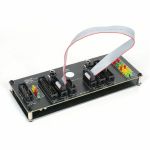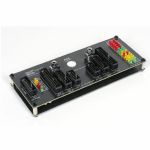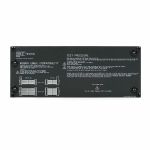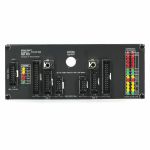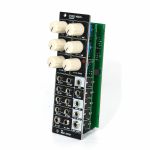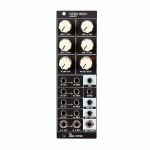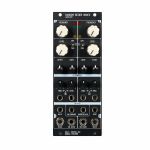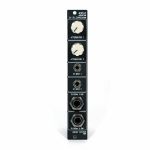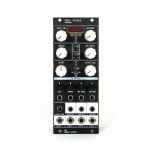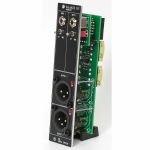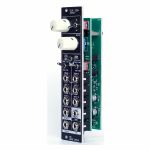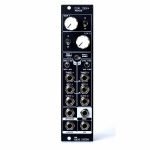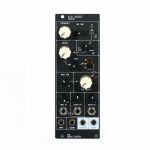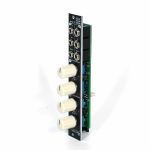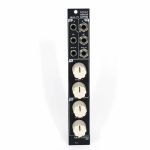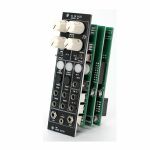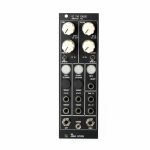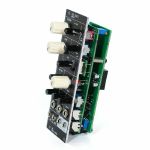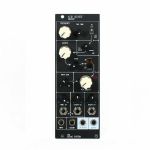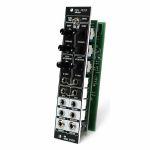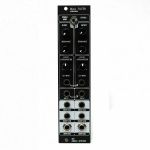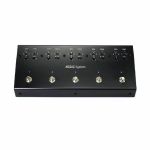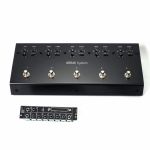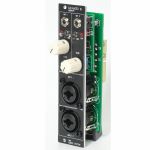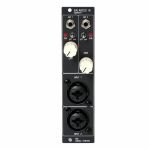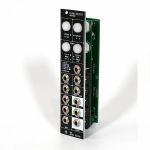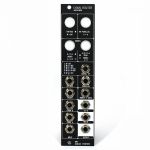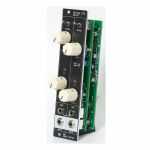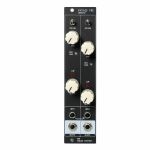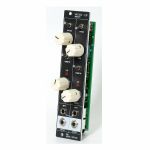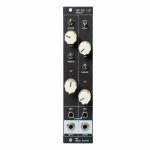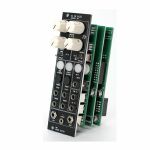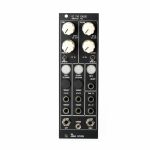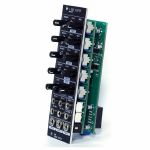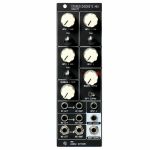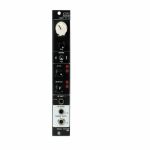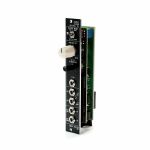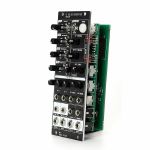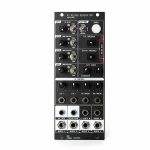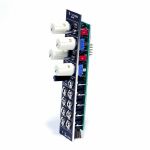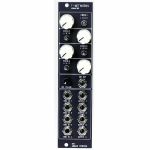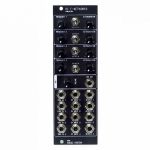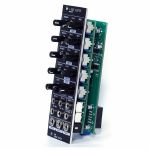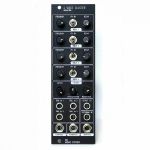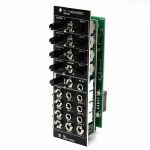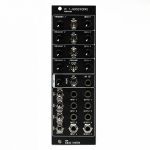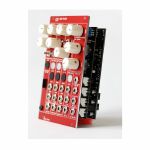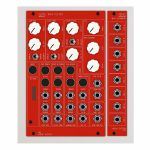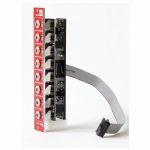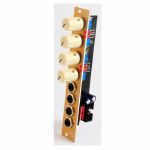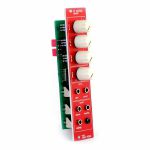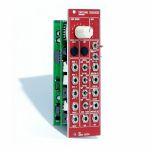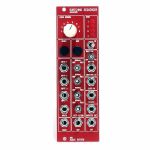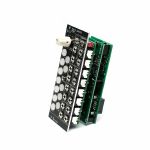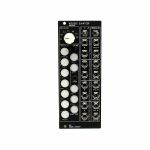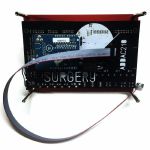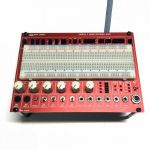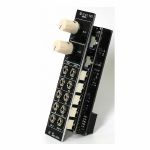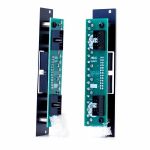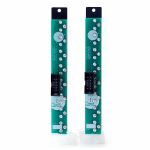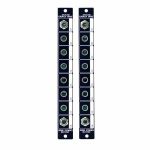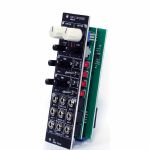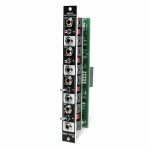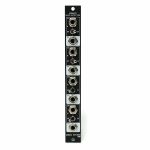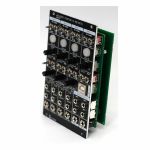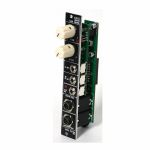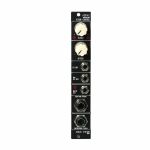Studio equipment
Our full range of studio equipment from all the leading equipment and software brands. Guaranteed fast delivery and low prices.
DJ equipment
Our full range of DJ equipment from all the leading equipment and software brands. Guaranteed fast delivery and low prices. Visit Juno DJ
Filter
Stock
Coming Soon
Format
Brand
Featured
Price
Tags
Individual Wire Testing - Featuring the ability to test each wire within the ribbon cables independently with dedicated LEDs for every wire, providing a clear visual indication of the status of each connection, wires are also tested against their neighbouring wires to detect shorts.
Busboard monitor
The busboard monitor LEDs allows the user to check the state of the busboard power lines as well as the special CV/Gate functions. If the busboard has no +5v supply the led will be off likewise for the CV/Gate functions if not in use.
This is a desktop device, ADDAC provide a long power cable so that it can still be plugged into your rack.
As a safety precaution only power this board when you need to test a cable. Leaving it ON at all times can lead to unintended problematic misuses which, in a worst case scenario, can shorten your Eurorack PSU,
! WARNING !
DO NOT POWER MODULES FROM THE TEST SOCKETS!!
Compatible with all ADDAC System ribbon cables (power, expansions and interconnectivity: 112, 213, 807).
Also compatible with any standard Eurorack power ribbon cable (2x5 to 2x8 or 2x8 to 2x8).
! WARNING !
NOT ALL MANUFACTURERS FOLLOW THESE STANDARDS!
ALLWAYS NOTICE THE ORIENTATION OF THE HEADERS IF YOUR CABLE DO NOT FOLLOW THE STANDARD THEN MOST PROBABLY IS NOT COMPATIBLE.
Tech Specs:
30mA +12V
30mA -12V
This product is available for pre-order at Juno, for shipping on the release date. You won’t be charged until the order is despatched.
We'll keep you informed of your order at every stage, and let you know if the release date changes.
If the price of the item drops before it's released, you will pay the lower price, but if it increases, you'll only pay the price you see today.
If you also include in-stock items on your order, they’ll be charged and shipped within 24 hours as usual.Four channels with stereo input and gain knob. Fifth channel with stereo input without gain knob, which are the prefered inputs to cascade several ADDAC813s when more channels are needed. Master Output controls the level of the Inputs mix. Two LEDs monitor the inputs mix.
Mono Send / Return return path allows for easy integration of mono effects in a stereo chain. Plug your favorite module through it (filter, bbd delay, spring reverb...) or any mono pedal.
The Return Gain works in parallel with the Master Output, just like regular wet / dry controls.
The send output can be configured to be line or synth level via a jumper in the back.
Stereo output sums the Inputs Mix with the Return signal.
The Mono output is the sum of Left and Right outputs
Effect Pedals
Using the send output at Line level, the user can connect the send output directly into mono effect pedals and have the pedals output connected directly into the return input without the need of an attenuator/amplifier module.
Tech Specs:
8HP
4 cm deep
50mA +12V
50mA -12V
This product is available for pre-order at Juno, for shipping on the release date. You won’t be charged until the order is despatched.
We'll keep you informed of your order at every stage, and let you know if the release date changes.
If the price of the item drops before it's released, you will pay the lower price, but if it increases, you'll only pay the price you see today.
If you also include in-stock items on your order, they’ll be charged and shipped within 24 hours as usual.This product is available for pre-order at Juno, for shipping on the release date. You won’t be charged until the order is despatched.
We'll keep you informed of your order at every stage, and let you know if the release date changes.
If the price of the item drops before it's released, you will pay the lower price, but if it increases, you'll only pay the price you see today.
If you also include in-stock items on your order, they’ll be charged and shipped within 24 hours as usual.Instead of using an expression pedal into the effects pedal the user can use this module in between a CV source and the Effects pedal to be controlled.
This is a great way to control the available parameters on the effects pedals straight from a CV source.
ADDAC309 features 2 channels each with a CV Input with attenuator and a 1/4" jack output.
This is a passive module, the power needed for operation is taken from the pedal power instead of the modular frame, this allows for perfect matching of the pedal's operating voltage which can range from 3.3v to 9v.
Tech Specs:
4HP
3,5cm deep
Passive module
This product is available for pre-order at Juno, for shipping on the release date. You won’t be charged until the order is despatched.
We'll keep you informed of your order at every stage, and let you know if the release date changes.
If the price of the item drops before it's released, you will pay the lower price, but if it increases, you'll only pay the price you see today.
If you also include in-stock items on your order, they’ll be charged and shipped within 24 hours as usual.Finally imagine the buoys would wirelessly transmit their absolute height directly to your module outputs where they would be mapped to a voltage signal.
ADDAC use a Gerstner Wave as the motor behind the two-dimensional wave generation. In fluid dynamics a Gerstner Wave is described as "a progressive wave of permanent form on the surface of an incompressible fluid of infinite depth". Gerstner waves are often used in computer graphics to simulate any type of water surface, if you've seen any animation film or computer game with water surfaces in it most probably it features a Gerstner wave generating it.
Tech Specs:
10HP
4.5cm deep
70mA +12V
40mA -12V
This product is available for pre-order at Juno, for shipping on the release date. You won’t be charged until the order is despatched.
We'll keep you informed of your order at every stage, and let you know if the release date changes.
If the price of the item drops before it's released, you will pay the lower price, but if it increases, you'll only pay the price you see today.
If you also include in-stock items on your order, they’ll be charged and shipped within 24 hours as usual.The Send channels attenuate the synth level to instrument level.
The Return channels amplify the signal from instrument to synth level.
Specs:
- Width: 4 HP
- Depth: 3 cm
- Max current: 10mA
quote 776156
There are two independent channels on the module with:
Audio Input
LIFT/FLOAT/GND toggle switch
Signal overload warning led
XLR Output
The LIFT/FLOAT/GND 3-way switch lets you choose between lift, ground or floating ground.
In the LIFT position (left) the module circuit will be "lifted" to ground through a 100R resistor and a 10nF capacitor.
In the FLOAT position (middle) Ground will not be shared leaving ins and outs grounds completely apart from each other fully isolating both signals. in the GND position (right) Ground will be shared between inputs and outputs, here no isolation is used.
Any of these three positions may be the best form of avoiding ground loops or any other undesired interference occurring between your modular and the sound system you're plugging it into. Try out which one of these options will work best in any given situation.
Tech Specs:
6HP
4 cm deep
40mA +12V
40mA -12V
The importance of using Audio Transformers
Applying a transformer balanced output isolation has lots of advantages over other less expensive ways for dealing with ground loop issues. This method provides the chance to set a very simple and clean circuit in which the signal transfer process develops smoothly and humming free. The transformer is a device that performs both signal balancing and high-to-low (or vice-versa) impedance conversion, while rejecting straggled DC voltage and Radio Frequency Interference from signal passing through a magnetic bridge. In a transformer, two (or more) coils (called windings) of insulated wire wound around a magnetic metal core allow for its input(s) and output(s) not to be physically connected together. When an AC signal passes through the input winding (the primary), a perfectly related AC signal appears on the output winding (the secondary). This way, by the fact that signal flows via inductive coupling between the two windings of the transformer, this module presents a most accurate electrical isolation between its input and output. A same number of windings on each coil guarantees that there's no gain loss when audio signal passes from the primary to the secondary windings. Furthermore, since these two windings are insulated from each other, the transformer will electrically isolate ADDAC710 from any other device, preventing hum problems coming from an outsider ground. Being a low-cost transformer the frequency response curve is not as linear as our 800X, still the -0.2dB attenuation at 50Hz feels negligible.
Phantom Power
+48V Phantom Power is NOT needed for the module to operate.
In any case having Phantom Power ON won't influence the module operation.
At its core it features a noise source and two precision Sample & Holds with 0.01% of maximum deviation from the Input which allows for quantized signals to be sent through without any noticeable detuning or the typical voltage drops over time.
The Sample & Hold sections can also be used as a Track & Hold meaning it holds the incoming input while the Trigger input is ON and lets the input flow to the output when the Trigger input is OFF.
Each section also features it's own slew processor with a single control over attack and decay and an ON/OFF switch.
The noise signal is normalled to both sections inputs, meaning that without a jack plugged into the Input the sample and hold function will act upon the incoming noise signal generating random CV values.
The [Trigger A Alternate] switch allows to Link both sections so that any trigger input in Trigger A will alternate between triggering the A and B section.
Besides each section outputs there's also 4 extra outputs: Noise, Difference, Average and Sum. The Noise output is coming from the noise source, the Difference output is the subtraction of section A minus section B, the Average output is the sum of both A plus B and then divided by 2 and finally the Sum output is the sum of both A plus B sections.
MECHANICAL:
Format: Eurorack
Width: 6 HP
Depth: 4 cm
ELECTRICAL:
Max current: +50mA/-50mA
Bus Board Cable: 8 × 2 IDC (Doepfer style) connector
Supplier's Notes:
ADDAC started this module with the idea of developing a complex drum source however, somewhere along the process, it was clear how much better it performed as a synth voice and this lucky accident was embraced.
It features a VCO with a [FREQUENCY] and [FINE TUNE] knob plus a dedicated CV Input and Attenuator knob (tunable over 4 octaves).
The VCO waveform output is achieved by selecting either a Triangle or Saw through a switch. the selected waveform can then be mixed/balanced against the square wave. The resulting mix is then sent to the Filter.
The Filter features a [CUTOFF] and [RESO] resonance knob plus a Cutoff CV Input and Attenuverter knob.
A 3 position switch is used to select the filter type: Highpass, Bandpass or Lowpass.
The resulting output is then sent to the VCA.
The VCA features an Input with [INPUT GAIN] knob which at maximum can amplify the incoming signal by a factor of 2.
This is a very important control, it accepts any signal Trigger, Gate or CV. Whatever input is plugged in the signal is then fed through an AD with a very short attack and controllable decay through the [VCA DECAY] knob plus the CV Input and Attenuverter knob. The resulting slewed signal is then used to control the VCA gain.
This signal is also sent to the CV OUTPUT as well as the LED monitor.
The Accent input adds to the Input signal creating a different amplitude output.
The CV OUTPUT is normalled to the Frequency and Cutoff inputs.
Tech Specs:
9HP
4cm deep
80mA +12V
80mA -12V
The [INPUT GAIN] knob
Usually Attack/Decay envelopes have a maximum voltage of +5v, no matter if the input gate is +5v or above the AD will clip at +5v. In this case, this clipping method was not used, and instead ADDAC allowed the incoming voltage to determine the maximum AD voltage, meaning that if a +5v gate is present then the AD maximum voltage will be +5v but if a gate of +10v is sent then the AD maximum voltage will be +10v.
This also means that with higher input voltages the decay, although falling at the same speed, will be longer than with lower voltages as it has a longer range to go back to 0v.
As previously mentioned, The [INPUT GAIN] knob can amplify the incoming input by a factor of 2, allowing to use a standard +5v gate or envelope and being able to make the resultant AD go up to +10v.
The AD signal is responsible for opening the VCA. Up to +5v the VCA will open to unity gain above this value the VCA will start to amplify and eventually saturate and distort. This saturation will add harmonics to the signal which will change its gentle timbrical nature to a more unique and peculiar timbre that will make the module shine in Acid contexts.
Adding high levels of Resonance or even filter self oscillation in combination with high VCA saturation will create even more harmonics that ADDAC highly encourage the user to explore.
quote 944224
Now more compact in 6hp and with an Offset CV input.
The incoming signal amplitude is controlled by a [GAIN] attenuverter circuit allowing to attenuate the signal as well as invert its phase.
A back jumper can set the maximum gain amount to either x1 (unity gain) or x10. DIY modifications can be made by changing its resistors.
After the Gain an offset can be added to the signal, displacing the signal up or down (-5V to +5V) this can be adjusted using the [OFFSET] knob and CV input
When using no input using the [OFFSET] knob and CV input will generate an output between -5V and +5V.
Tech Specs:
6HP
2.5 cm deep
40mA +12V
40mA -12V
1 in stock $81.36
This is Version 2 of this module, updated in order to be skiff friendly.
With the ADDAC102 FM Radio you'll be able to tune-in FM radio. Besides the ability of station broadcasts as sound generators for your synthesis, you can also have a lot of fun with the fact that its a great noise generator- the static picks up all kinds of great electromagnetic interference.
It provides controls like tune, volume and seek (all of them controllable through CV input) and there's two outputs for stereo sound.
A fresh twist on a simple 303-style acid synth, featuring a triangle/sawtooth/square wave VCO, multi-mode resonant filter, simple AD envelope and a VCA which can be overdriven. Excellent value.
Supplier's Notes:
ADDAC started this module with the idea of developing a complex drum source however, somewhere along the process, it was clear how much better it performed as a synth voice and this lucky accident was embraced.
It features a VCO with a [FREQUENCY] and [FINE TUNE] knob plus a dedicated CV Input and Attenuator knob (tunable over 4 octaves).
The VCO waveform output is achieved by selecting either a Triangle or Saw through a switch. the selected waveform can then be mixed/balanced against the square wave. The resulting mix is then sent to the Filter.
The Filter features a [CUTOFF] and [RESO] resonance knob plus a Cutoff CV Input and Attenuverter knob.
A 3 position switch is used to select the filter type: Highpass, Bandpass or Lowpass.
The resulting output is then sent to the VCA.
The VCA features an Input with [INPUT GAIN] knob which at maximum can amplify the incoming signal by a factor of 2.
This is a very important control, it accepts any signal Trigger, Gate or CV. Whatever input is plugged in the signal is then fed through an AD with a very short attack and controllable decay through the [VCA DECAY] knob plus the CV Input and Attenuverter knob. The resulting slewed signal is then used to control the VCA gain.
This signal is also sent to the CV OUTPUT as well as the LED monitor.
The Accent input adds to the Input signal creating a different amplitude output.
The CV OUTPUT is normalled to the Frequency and Cutoff inputs.
Tech Specs:
9HP
4cm deep
80mA +12V
80mA -12V
The [INPUT GAIN] knob
Usually Attack/Decay envelopes have a maximum voltage of +5v, no matter if the input gate is +5v or above the AD will clip at +5v. In this case, this clipping method was not used, and instead ADDAC allowed the incoming voltage to determine the maximum AD voltage, meaning that if a +5v gate is present then the AD maximum voltage will be +5v but if a gate of +10v is sent then the AD maximum voltage will be +10v.
This also means that with higher input voltages the decay, although falling at the same speed, will be longer than with lower voltages as it has a longer range to go back to 0v.
As previously mentioned, The [INPUT GAIN] knob can amplify the incoming input by a factor of 2, allowing to use a standard +5v gate or envelope and being able to make the resultant AD go up to +10v.
The AD signal is responsible for opening the VCA. Up to +5v the VCA will open to unity gain above this value the VCA will start to amplify and eventually saturate and distort. This saturation will add harmonics to the signal which will change its gentle timbrical nature to a more unique and peculiar timbre that will make the module shine in Acid contexts.
Adding high levels of Resonance or even filter self oscillation in combination with high VCA saturation will create even more harmonics that ADDAC highly encourage the user to explore.
out of stock $198.67
Really nice stuff here. The filter circuit from ADDAC's 4 Voice Cluster module gets reimagined as a multi-mode stereo or dual mono filter module. A lot of filter action in just 6hp.
Supplier's Notes:
While developing the ADDAC105 4 Voice Cluster module, a new multimode filter to place after the summing mix stage- and the results were so postitive that it was released as a dedicated filter.
To make it more interesting, the circuitry was duplicated, to be able to use it in a stereo signal path.
To make it more versatile, a switch was added to set the working mode from Stereo to Dual Mono where both filters can be used independently.
In Stereo Mode the Left Cutoff is used to control the Right Cutoff.
In this case the Right Cutoff Knob and CV Input are simply bypassed and will have no impact on the Right Channel operation.
This allows immediate sync of both filter frequencies when the Stereo position is engaged.
Optionally there's a jumper in it's back that, when placed, connects the Right Controls back to the Right CV control allowing the possibility to control the offset of the Right Channel Cutoff.
Resonance is independent on both Modes and still has to be set manually to match both channels.
Both the Audio and CV inputs are normalled from the Left into the Right channels.
As standard plugging any input to the Right channels removes this connection.
Tech Specs:
6HP
4 cm deep
70mA +12V
70mA -12V
However, feet have been underrated while using modulars. In the past ADDAC released a series of modules using sustain and expression pedals for triggering or controlling signals to help breaking the ice. While these are small and still useful for simple uses, ADDAC wanted to create something more specific this time.
This new solution features 5 footswitches and 5 inputs for external expression pedals with independent controls for each.
The aim was to save HP rack space and so created an external floor pedal with all the footswitches and controls, keeping the module HP to the minimum possible featuring only the 10 outputs and the connector to the external floor pedal.
There are many expression pedals in the market and although the most common one is the TRS pedal there are 2 other standards: RTS and TS.
All five ADDAC311 inputs expect TRS pedals, if you're looking into buying one choose a TRS pedal.
If you already have other pedals channel 4 features jumpers that can be switched in order to be used with a RTS pedal.
Channel 5 features a jumper that can be switched in order to be used with a TS pedal.
External expression pedals are required for their outputs to work.
External expression pedals are not included
3 in stock $288.92
There are two independent channels on the module with:
Audio Output
Signal overload warning led
LIFT/FLOAT/GND toggle switch
Gain control
XLR Input
The LIFT/FLOAT/GND 3-way switch lets you choose between lift, ground or floating ground. In the LIFT position (left) the module circuit will be "lifted" to ground through a 100R resistor and a 10nF capacitor. In the FLOAT position (middle) Ground will not be shared leaving ins and outs grounds completely apart from each other fully isolating both signals.
In the GND position Ground will be shared between inputs and outputs, here no isolation is used. Any of these three positions may be the best form of avoiding ground loops or any other undesired interference occurring between your modular and the external hardware. Try out which one of these options will work best in any given situation.
The importance of using Audio Transformers
Applying a transformer balanced input isolation has lots of advantages over other less expensive ways for dealing with ground loop issues. This method provides the chance to set a very simple and cleancircuit in which the signal transfer process develops smoothly and humming free. The transformer is a device that performs both signal balancing and high-to-low (or vice-versa) impedance conversion, while rejecting straggled DC voltage and Radio Frequency Interference from signal passing through a magnetic bridge. In a transformer, two (or more) coils (called windings) of insulated wire wound around a magnetic metal core allow for its input(s) and output(s) not to be physically connected together. When an AC signal passes through the input winding (the primary), a perfectly related AC signal appears on the output winding (the secondary). This way, by the fact that signal flows via inductive coupling between the two windings of the transformer, this module presents a most accurate electrical isolation between its input and output. A same number of windings on each coil guarantees that there's no gain loss when audio signal passes from the primary to the secondary windings. Furthermore, since these two windings are insulated from each other, the transformer will electrically isolate ADDAC711 from any other device, preventing hum problems coming from an outsider ground. Being a low-cost transformer the frequency response curve is not completely linear, still the -0.2dB
attenuation at 50Hz feels negligible.
Six routing patterns are allowed:
1. IN > OUT
2. IN > CHAIN A > OUT
3. IN > CHAIN B > OUT
4. IN > CHAIN A > CHAIN B > OUT
5. IN > CHAIN B > CHAIN A > OUT
6. IN > > OUT
A practical example is to have an audio source, a delay and a looper.
And the question: should the delay be placed before or after the looper? Sometimes you may need the delay to be before the looper as you may want to sample the audio with the delay or sample the pure audio source and apply the delay afterwards.
This small utility module solves this issue on the fly without having to repatch anything.
INPUTS & OUTPUTS
TO CHAIN B: Connect to your Chain B input
FROM CHAIN B: Connect to your Chain B output
TO CHAIN A: Connect to your Chain A input
FROM CHAIN A: Connect to your Chain A output
INPUT: Connect to your Input Source
OUTPUT: Connect to your Output Source
ROUTING PATTERNS
There are 2 ways to address the six routing patterns:
Buttons: using the frontpanel push buttons and/or dedicated trigger inputs to latch between 2 states.
BYPASS: Chooses between Pattern 1 and any other pattern
PARALLEL: Chooses between Pattern 6 and any other pattern
ORDER: Chooses the order A before B or B before A
DUAL/SINGLE: Chooses to use a Dual (A>B or B>A) or Single chain (A or B)
CV: The dedicated CV input expects a 0 to +5v input and allows to jump to the precise routing pattern using a specific voltage interval in increments of approx. 0.83V:
Pattern 1: 0v to 0.83v
Pattern 2: 0.83v to 1.66v
Pattern 3: 1.66v to 2.5v
Pattern 4: 2.5v to 3.33V
Pattern 5: 3.33v to 4.16V
Pattern 6: 4.16v to 5V
Tech Specs:
Width: 12 HP
Depth: 55mm
Current: 80mA +12V / 30mA -12V
3 in stock $125.36
What was eye-catching was the character of its clipping and resulting saturation/distortion.
The module can be used with modular signals to add a distortion/fuzz character or as a preamp for an external source such as a line source, keyboard, guitar...
It's also a great side companion for our ADDAC711 Balanced Inputs.
At the top an On/Off [BYPASS] switch routes the signal into the Effect (Up: Active) or to the bottom output gain stage (Down: Bypassed).
The amount of amplification is set by the [GAIN] control, the maximum amount of amplification can be set by the user using the [MAX GAIN] trimmer.
Up to +/-5.5v the incoming signal will keep it's integrity, beyond this point saturation will start to increase.
At approx. +/-6v a hard clipping will start to occur, this clipping also has a particular quality that at extreme levels it drifts the audio 0v bias reference, moving it upwards which results are similar to a Gate effect.
In the middle, an x2 opamp based output gain stage with a clipping led, which monitors the clipping at the output, and an [OUTPUT] control to set the output volume.
Having the top and middle gain stages provides flexibility allowing the user to completely distort the signal on the top stage and tame it's output level with the second stage.
At the bottom, Input and Output for both channels (Left input is normalled into Right input).
Tech Specs:
6HP
4 cm deep
40mA +12V
40mA -12V
quote 917638
Diode based passive clipping acts as a "brick wall" limiter with a fixed knee given by the inherent diode physics. A passive RC low pass circuit adds a 3.3KHz -3db low pass filter which sculpts the overall tone while also adding further character to the effect.
At the top an On/Off [BYPASS] switch routes the signal into the Effect (Up: Active) or to the bottom output gain stage (Down: Bypassed).
The amount of clipping is set by the [GAIN] control, it mostly works as a threshold control for how much clipping will be applied.
As more clipping is applied the signal's amplitude will also decrease, to compensate for this we set up a gain compensation stage to keep the output amplitude balanced across the Gain range.
Symmetry chooses between bipolar clipping or positive clipping, this relates to the harmonics generated, bipolar for odd and even harmonics (up position) and unipolar for odd harmonics only (down position).
At the second stage, an opamp based x2 output gain with a clipping led, which monitors the clipping at the output, and an [Output] control to set the output volume.
Having the top and middle gain stages provides flexibility allowing the user to completely distort the signal on the top stage and tame it's output level with the second stage.
At the bottom, Input jacks for both channels (Left input is normalled into Right input) and output jacks
Tech Specs:
6HP
4 cm deep
40mA +12V
40mA -12V40mA +12V
40mA -12V
quote 917651
With the ADDAC102 FM Radio you'll be able to tune-in FM radio. Besides the ability of station broadcasts as sound generators for your synthesis, you can also have a lot of fun with the fact that its a great noise generator- the static picks up all kinds of great electromagnetic interference.
It provides controls like tune, volume and seek (all of them controllable through CV input) and there's two outputs for stereo sound.
Following the ADDAC103 T-Networks, this new module is inspired by it's simplicity. This is a 4 voice Square Oscillator with VCA, FM switch and a slew decay for the incoming Trigger IN. All voices are then sent through a Multimode Filter.
Each voice has it's own VCA input where any input is accepted (Trigger, Gate, CV) The [DECAY] controls the slew decay applied to the incoming signal, if [DECAY] is fully anti-clockwise then it works as a Mute. The [FM ON] switches activate/deactivate the FM input coming from the previous voice: Voice 1 FM comes from voice 4, voice 2 FM comes from voice 1, and so on, so you can FM all of them in a FM loop.
All 4 voices are summed and sent through a filter with controls over [CUTOFF] with an Attenuverter for the CV input and [RESO- NANCE]. Three filter outputs are provided [LOWPASS], [BANDPASS] and [HIGHPASS]
The [EXTERNAL IN] input can be routed through a jumper on the back of the module allowing the incoming signal to go to:
the filter input for processing an external audio source.
all of the 4 voices Frequency control allowing for some experi- mental CV control over pitch of all 4 voices at the same time (due to the specificities of the circuit and to keep the module at a low price these inputs are not callibrated to 1v/octave).
This is the last module in Addac System's T-Networks series, a straight forward 4 voice module with frequency and decay controls for each of the voices. As the name already unveils, a noise source has been added, and 2 different circuits have been created, that explore the timbre of a t-network when used to filter noise.
There are 2 different circuits in this module, voices 1 to 3 have a pre-vca t-network filter while in voice 4 the t-networks filter applied post-vca.
At each voice input there's a switch which sets which type of input to use, this signal will be used to control an internal VCA hence why the type of setting defined here is important:
1. Trigger - Any incoming CV will be converted into a 1ms trigger as soon as it crosses it's fixed threshold.
2. Mute - This disconnects then incoming signal effectivelly muting the voice.
3. Envelopes - This can be used with CV sources as well as Gate sources and simply follows the input signal.
This incoming signal will then be processed by a slew circuit which adds a decay factor allowing the user to set the "Tail" of each voice.
Trigger mode is mostly dedicated for percussive sounds while the Envelope mode is open to any external enve- lope control and able to control noise swooshes, swirls, crackles and pops simply out of t-networks filtered noise.
Audio inputs are also welcomed to be used as a Trigger/Envelope input.
Diferences between voices:
The first 3 voices also feature a Timbre selector switch: Hat/Snare
In Snare mode all frequencies coming from the t-networks filter pass thru to the output .
In Hat mode it adds a High Pass circuit which removes the mid/bottom frequencies (characteristic of the snare strike) creating a higher spectrum output which is closer to a Hat timbre.
All of these 3 voices are also differently tuned from each other to offer more timbrical options.
Voice 4 is closer to a typical t-networks circuit but this time peculiar one where the noise is gated by the vca and then sent through the t-networks filter.
Hat and Snare are terms used very looselly here, they are timbrical references and do not in any shape or form try to effectivelly replicate the complex timbres of a real world Hat or Snare.
Supplier's Notes:
ADDAC713 is the stereo version of ADDAC System's 703 Discrete Mixer.
Inspired by Moog's CP3 mixer, this is a fully discrete analogue mixer and it's not, by any means, your standard breakfast mixer, although it can behave like one.
This is a wolf in sheep's clothing. Despite its harmless looks there's a dark snarly soul behind that panel that wants to take your sounds into a realm of gritty gnarly growls.
This new version was initially thought of as a percussion mixer, with mono inputs and panning, to allow placing percussive voices in the stereo field, while keeping channel 4 in mono for low end sources like a kick drum or Bass. In the development process ADDAC System slightly changed this initial idea, adding stereo inputs for the first 3 channels, but still kept the 4th channel in mono.
All four [GAIN] controls go to extreme levels, the first 3channels also feature [PAN] controls. Feedback is used to overdrive the whole mix. As the control is turned clockwise the sound will be clipped harder until it goes completely off, this happens as feedback is increased the audio bias reference also moves up, at extreme levels it offsets the whole signal upwards until it completely goes above the top rail clipping the whole signal hence the resulting gate effect.
The [MASTER OUTPUT] sets the overall output gain of the mixer, the two leds monitor the audio output signal. The Soft clipping switch engages an anti-click circuit which adds a low pass before the output, the switch allows 3 states: Soft low pass / Off / Hard low pass.
Features:
Three channels with stereo inputs, gain and pan knob
One channel with mono input and gainknob
Feedback/gate knob
Master output volume knob
Soft clipping switch
Two Led Monitors for Left and Right channels
Tech Specs:
8HP
4cm deep
80mA +12V
80mA -12V
out of stock $207.56
This module features 3 independent Attenuverters each with its input, output and 13mm knob.
White areas allow the user to write down what is connected to each channel.
Channel 1 is normalled to Channels 2 and 3.
40 mA +12V
40 mA -12V
0 mA 5V
25 mm deep
out of stock $77.83
Supplier's Notes:
Another addition to ADDAC 300's Expressive Controls series.
This module converts the incoming light hitting an external light sensor into 2 Bipolar CV Streams:
Output: More light > Higher CV output
Inverted Output: More light > Lower CV output
The external sensor is enclosed in a jack socket in order to be used with any standard jack cable and be able to place it in any place outside the eurorack frame.
There are several controls to adjust the CV Output's signals:
Sensitivity:
Adjusts the Light Sensor sensitivity to Light- the higher the sensitivity, the better it responds to low light situations
Response:
3 fixed settings (medium/fast/slow) to set the slew applied to the raw signal coming from the sensor.
Gain:
Sets the gain for both outputs
Offset:
Adjusts the Offset for the main Output.
Inverted Offset:
Adjusts the Offset for the Inverted Output.
50 mA +12V
50 mA -12V
0 mA 5V
45 mm deep
out of stock $90.50
Supplier's Notes:
The TILT EQ concept was first introduced in the 1970's by Quad Ltd, featured on the company's model 34 preamplifier.
The tilt control tilts the frequency spectrum of the audio signal by simultaneously boosting the treble and cutting the bass frequencies, or vice versa, making it a simple to use but powerful EQ.
As stated by Quad Ltd, it was designed to produce a very gradual change in balance across the musical spectrum without changing the overall subjective level.
This gradual fall from Bass to Treble, or vice versa, means there's no sudden change and hence no 'coloration' added to the sound, the sound will remain entirelly natural but with a slight added bottom or high end. In practice, it rotates most of the audio-range frequency response around a 1Khz axis, so as to change the overall balance of the sound from warm to cool without affecting either the apparent volume or the "color" of the sound.
Here this idea is introducedinto the modular world in a stereo configuration.
CV input with attenuverter was added for the Tilt control as well as a Spectral Motion switch that allows stereo spectral matching or inverted spectrum use of the Tilt control: Left=Right matches both channels direction, i.e. when left channel is tilted to the low end the right channel will also be tilted to the low end
Left Right inverts the Right channel spectrum, i.e. when left channel is tilted to the low end the right channel will be inverselly tilted to the high end, or vice-versa.
This possibility is extremmelly interesting when applied as a stereo effect, in other words a spectral EQ panner. This module will also be available as a full DIY kit.
Specs:
4Hp
4.5cm deep
40mA on each rail
Supplier's Notes:
In 2009 John Berndt coined and defined the term Relabi in his essay "Relabi": Patterns of Self-Erasing Pulse, these are his own words: "Relabi, Def.: The experience of a palpably coordinated plurality of events that appears to be cyclical but simultaneously suspends identification of a uniform pattern, preventing a resolved sense of pulse. Relabi therefore seems equally pulsed and unpulsed at the same time. It is an experiential gestalt, a quality of experience, greater than the sum of its parts (it forms a sustained unity in experience, albeit of a new kind)."
He also makes the question: "Why would anyone want this Relabi experience? I maintain that much of what is exciting in musical forms involves an interplay between the setting up and denying of pulse expectations."
Inspired by this idea, ADDAC System developed this module that is both a gate/trigger and cv generator that can be freely used to trigger events or act as a complex modulation source. Four Sine LFOs are internally generated, each has controls for gain, frequency and mute(off). These 4 LFOs are then mixed together to generate what Berndt named the "Relabi Wave" this "wave" becomes a complex bipolar CV source. This i5v bipolar "wave" can be monitored on the 2 dedicated leds and is also available at its own Output.
Make sure to check the User's Guide for indepth description, working behaviour and diagrams.
Tech Specs:
10HP
4cm deep
100mA +12V
40mA -12V
1 in stock $251.15
At each voice input there's a gate to trigger converter so any input source is possible.
Audio inputs can also be used as an input, in this case and due to the nature of the gate to trigger converter, each voice can be used as very destructive filters.
The top 2 channels feature a higher frequency range, the bottom 2 channels feature a lower frequency range.
Tech Specs:
6HP
2.5 cm deep
40mA +12V
40mA -12V
At each voice input there's a gate to trigger converter so any input source is possible.
Audio inputs can also be used as an input, in this case and due to the nature of the gate to trigger converter, each voice can be used as very destructive filters.
The top 2 channels feature a higher frequency range, the bottom 2 channels feature a lower frequency range.
Each voice has it's own VCA input where any input is accepted (Trigger, Gate, CV) The [DECAY] controls the slew decay applied to the incoming signal, if [DECAY] is fully anti-clockwise then it works as a Mute. The [FM ON] switches activate/deactivate the FM input coming from the previous voice: Voice 1 FM comes from voice 4, voice 2 FM comes from voice 1, and so on, so you can FM all of them in a FM loop.
All 4 voices are summed and sent through a filter with controls over [CUTOFF] with an Attenuverter for the CV input and [RESO- NANCE]. Three filter outputs are provided [LOWPASS], [BANDPASS] and [HIGHPASS]
The [EXTERNAL IN] input can be routed through a jumper on the back of the module allowing the incoming signal to go to:
the filter input for processing an external audio source.
all of the 4 voices Frequency control allowing for some experi- mental CV control over pitch of all 4 voices at the same time (due to the specificities of the circuit and to keep the module at a low price these inputs are not callibrated to 1v/octave).
There are 2 different circuits in this module, voices 1 to 3 have a pre-vca t-network filter while in voice 4 the t-networks filter applied post-vca.
At each voice input there's a switch which sets which type of input to use, this signal will be used to control an internal VCA hence why the type of setting defined here is important:
1. Trigger - Any incoming CV will be converted into a 1ms trigger as soon as it crosses it's fixed threshold.
2. Mute - This disconnects then incoming signal effectivelly muting the voice.
3. Envelopes - This can be used with CV sources as well as Gate sources and simply follows the input signal.
This incoming signal will then be processed by a slew circuit which adds a decay factor allowing the user to set the "Tail" of each voice.
Trigger mode is mostly dedicated for percussive sounds while the Envelope mode is open to any external enve- lope control and able to control noise swooshes, swirls, crackles and pops simply out of t-networks filtered noise.
Audio inputs are also welcomed to be used as a Trigger/Envelope input.
Diferences between voices:
The first 3 voices also feature a Timbre selector switch: Hat/Snare
In Snare mode all frequencies coming from the t-networks filter pass thru to the output .
In Hat mode it adds a High Pass circuit which removes the mid/bottom frequencies (characteristic of the snare strike) creating a higher spectrum output which is closer to a Hat timbre.
All of these 3 voices are also differently tuned from each other to offer more timbrical options.
Voice 4 is closer to a typical t-networks circuit but this time peculiar one where the noise is gated by the vca and then sent through the t-networks filter.
Hat and Snare are terms used very looselly here, they are timbrical references and do not in any shape or form try to effectivelly replicate the complex timbres of a real world Hat or Snare.
While keeping all functions of the original, there's more dedicated controls as well as a few new functions.
For this version, Micro SD Cards were used- this decision was made in order to help the hardware construction and make it only 3cm deep.
An Expansion module, ADDAC111B, was also created to allow users to recall the first 8 files through dedicated trigger signals. This allows sequencing of files.
The Loop Size, Start Point and Sample Rate defines how the loop is played.
Loop Settings defines if sample is looping or playing only once.
File Access if it advances to the next or previous file.
The VCA section controls the overall volume of the module.
And finally the Envelope Follower generates a CV voltage related to the amplitude of the audio signal pre-VCA.
out of stock $341.45
Files do not play simultaneously, if several triggers happen at the same time top priority goes from top to bottom- meaning that if B E and F triggers are received at once the file that will be played is file B.
The expansion module should be plugged to the back of the Ultra .Wav Player module. There's no connection to the bus boards.
Specificaitons:
Mechanical:
Format: Eurorack
Width: 16 hp
Depth: 3 cm
Control voltage i/o:
CV inputs: i 5v
CV outputs: 0 +10v
Electrical:
Max current: 150ma
Compatible with +-12v and +-15v power supplies
Bus board cable: 8x2 idc (doepfer style) connect
Mechanical:
- Format: Eurorack
- Width: 4 HP
- Depth: 3.5 cm
Electrical:
- Passive
Two channels for your mapping needs.
Mechanical:
- Format: Eurorack
- Width: 4 HP
- Depth: 3 cm
Control Voltage I/O:
- CV inputs: i 10v
- CV outputs: i 10v
Electrical:
- Compatible with +-12v and +-15v power supplies?
- Max current: 50mA
- Bus Board Cable: 8 × 2 IDC (Doepfer style) connector
out of stock $123.51
It also features two leds per channel, to monitor your output polarity.
MECHANICAL:
Format: Eurorack
Width: 4 HP
Depth: 2.5 cm
CONTROL VOLTAGE I/O:
CV inputs: i 10v
CV outputs: i10v
ELECTRICAL:
Max current: 30mA
Compatible with +-12v and +-15v power supplies
Bus Board Cable: 8 × 2 IDC (Doepfer style) connector
This module provides two outputs for normal and inverted output voltages. A third output morphs between the normal and inverted outputs.
Mechanical:
. Format: Eurorack
. Width: 6 HP
. Depth: 2 cm
Control Voltage I/O:
. CV inputs: i 10v
. CV outputs: i 10v
Electrical:
. Compatible with +-12v and +-15v power supplies?
. Max current: 40mA
. Bus Board Cable: 8 × 2 IDC (Doepfer style) connector
out of stock $133.88
Among many other possibilities it allows to:
Turn any 4x4 step sequencer into a 16 step sequencer.
Scramble sequences with diferent clock division settings.
Route 1 audio or voltage signal to 4 diferent destinations.
Switch between 4 audio or voltage signals
MECHANICAL:
Format: Eurorack
Width: 8 HP
Depth: 3.5 cm
ELECTRICAL:
Max current: +80mA/-40mA
Bus Board Cable: 8 × 2 IDC (Doepfer style) connector.
Mechanical:
Format: Eurorack
Width: 10 HP
Depth: 5.2 cm
Control Voltage I/O:
CV inputs: i 5v
CV outputs: +10v
Electrical:
Max current: +140mA/-70mA
Bus Board Cable: 8 × 2 IDC (Doepfer style) connector
Normal glides have a fixed speed, they take X time to go up a semitone and X*12 to go up an octave. A compensation circuit was added to detect and dynamically change the speed according to the distance needed to be made, so that in the end it'll take the same time to reach the final destination no matter if the interval is 1 semitone or 3 octaves. This compensation feature (dry/wet) can controlled by the front panel knob or by CV.
Mechanical:
. Format: Eurorack
. Width: 4 HP
. Depth: 55 mm
Electrical:
. Max current: 60mA.
. Bus Board Cable: 8 × 2 IDC (Doepfer style) connector.
Included:
.black screws
.black fibre washers
Power sources:
-12V, +12V
-3/10V, +3/10V
Ships with: 1M Ribbon Cable and 55cm standoff Spacers for desktop operation, screws and nylon washers
Mechanical Specs:
Width: 36 HP
Depth: 3.5cm (i1.375 inches) with or without Arduino installed, Depth increases if using arduino shields.
The ADDAC212 is a 4-channel VC attenuator and off-setter. It lets you deal with up to four parallel inputs as a single pack, modulating their amplitude and offset (± 10V) with the same control knobs, both with cv inputs and dedicated attenuators.
Features 4 parallel VCAs with the same amplitude and offset control knobs and cv inputs with dedicated attenuators.
Idealized to be the perfect companion for Envelope Generators, you can send 4 EGs through it and control the overall amplitude and offset of all 4 envelopes at once. This allows more control over the Envelopes when patching typical synth voices.
Similar to a VC switcher but in this case there's the same number of inputs than outputs so, instead of 4 to 1 or 1 to 4, this module is always 4 to 4 but it can be patched for 2 to 2 and 3 to 3 step actions.
All four inputs get routed to the four outputs depending on the CV and Clock controls and are divided into 4 routing steps:
1. routes all inputs to the same number output: 1:1, 2:2, 3:3, 4:4
2. routes all inputs to an offset of 1: 2:1, 3:2, 4:3, 1:4
3. routes all inputs to an offset of 2: 3:1, 4:2, 1:3, 2:4
4. routes all inputs to an offset of 3: 4:1, 1:2, 2:3, 3:4
Direction determines if the clock input goes forward or backwards.
Going forward it can be set to 2-3 or 4 steps using the Rotate knob offset, going backwards always sync to 4 steps even if offseted by the Rotate knob.
For 2 & 3 step action input 1 is normalled to input 3 and input 2 is normalled to input 4.
Reset resets the internal clock to the first step.
Pendulum, external sequencing or any complex CV actions can be achieved using the CV input and dedicated attenuverter.
4 leds monitor which input is routed to output 1.
Use a pair of ADDAC213As to send & receive 8 CV or audio signals between distant points in your case, between two separate cases, or between your case and a friend's case. Less clatter, less spaghetti, faster connection! There's nothing better than being able to connect that controller skiff with just one cable to your main system. At a gig, in the studio, when jamming with a friend, give yourself a gift by grabbing a pair of ADDAC213As.The modules can be installed in normal position or a 180 degree position to fit any need and any case design.
Each ADDAC213A module can be connected through a ribbon cable connection on its backside with up to two ADDAC213Bs. Each ADDAC213B module added expands the channels options of the ADDAC213A by adding 8 more channels. With two 2 ADDAC213Bs connected to each ADDAC213A module, you'll have a total of 24 channels going between your cases with a simple one-cable bridge. Between the ADDAC213A pair and the ADDAC213B, your cases never looked so elegantly connected together!
The ADDAC213As are always sold as a pair of 2 modules and an included ribbon cable.
Each module can be installed in normal position or at 180 degrees.
Comes with a 50cm ribbon cable. Custom sizes are available upon request.
Mechanical:
. Format: Eurorack
. Width: 6 HP
. Depth: 2.4 cm
Electrical:
Passive / Does not draw current
Ribbon Cable: 50cm or 100cm ribbon cable
out of stock $101.71
A pair of ADDAC213Bs can be used in standalone to send/receive 8 CV or audio signals between different points inside the same case or as an expansion to the main pair of Eurorack Bridge modules, the ADDAC213As.
Two ADDAC213B modules can be connected to each other with the use of a single ribbon cable and then used inside a case to carry signals between distant points without the need for long cables. Less clatter, less spaghetti- more space of your fingers on those knobs!
ADDAC213Bs always come in pairs. A single pair can send & receive up to 8 CV or audio signals between different points in your case at the same time. The modules can be installed in normal position or a 180 degree position to fit any need.
As an Expansion to an ADDAC213A.
Each ADDAC213B connected to the backside of an ADDAC213A adds 8 more channels to the main bridging functionality of the ADDAC213A.
Up to 2 ADDAC213B can be connected to an ADDAC213A module, expanding the bridging between two difference cases to a total of 24 channels.
If you're looking for a simple one-cable bridge between your various cases, then look no further than the ADDAC213A.
Between the ADDAC213A pair and the ADDAC213B, your cases never looked so elegantly connected together!
Each module can be installed in normal position or at 180 degrees.
Comes with a 50cm ribbon cable. Custom sizes are available upon request.
Mechanical:
. Format: Eurorack
. Width: 3 HP
. Depth: 2.5 cm
Electrical:
Passive / Does not draw current
Ribbon Cable: 50cm or 100cm ribbon cable
2 in stock $86.14
This module is a peculiar type of mixer that instead of just summing two input signals (X & Y) it also allows the possibility to subtract the two signals.
It works both for audio and CV signals and hence the possibility to get the diference of two CVs or cancel the phase of two audio signals. The resulting signal, of sum or subtraction, is then routed through a switchable (on/off) full rectification circuit labeled: Absolute. After this the gain of the mixed signal goes through another attenuverter labeled: Amplitude to control the resulting signal gain which, being an attenuverter, also allows the possibility to invert the incoming signal. After the Amplitude comes an AC/DC coupling switch followed by an bipolar Offset knob.
Besides the normal output, there's also an inverted output for each of the A & B sections.
The outputs of section A & B are also summed and sent to the Average Output.
Using a single input, just the X or Y input, the module can also be used as a simple dual Attenuverter & Offset CV processor with full rectification and AC coupling options.
Average mix output of both sections.
This led to the simple yet effective Gate to Trigger.
A four channel converter with bypass switch for each channel.
Any input Gate will be limited to a 1ms Trigger.
Tech Specs:
3HP
2.5 cm deep
10mA +12V
10mA -12V
quote 776261
A dedicated software permits the user to store up to 9 different presets, where the CC values of each channel can be configured as wished.
This way the user can preset his favourite synths to control filters, envelopes and whatnot from CC messages coming from the module CV inputs.
Ships with 2 stereo jack to din5 midi cables.
out of stock $237.66
Ships with 2 TRS to MIDI type A cables (Korg, Make Noise...).
Note: All specifications and features are subject to change without previous notice.
It's also normal to have an expression pedal lying around somewhere, so ADDAC have brought these back, cleaned up the dust and put them to good use.
This module allows the connection of any standard expression and sustain pedal.
The expression pedal action can be fine-tuned with Range and Offset knobs.
Range defines the voltage range (-10v, +10v).
Offset transposes the range by (-5v, +5v).
Two leds, plus and minus, monitor the CV Output
Positive and inverted output jacks.
The sustain pedal action will generate a gate signal on the gate output.
One led monitors this output.
The module also features a bus board +5v Adaptor, this will be able to provide +5v to any bus board.
This feature can be removed through a jumper on the back of the module.
Specs:
- Width: 4 HP
- Depth: 4 cm
- Max current: 20mA
. Bus Board Cable: 8 × 2 IDC (Doepfer style) connector



